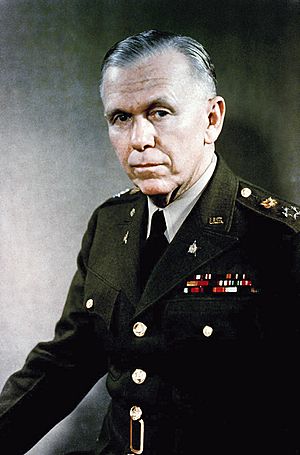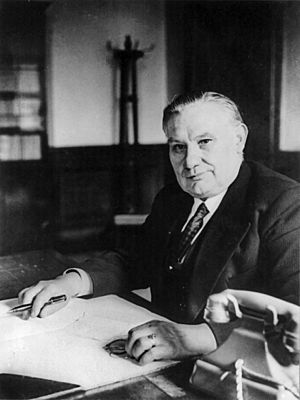Committee of European Economic Co-operation facts for kids
| Abbreviation | CEEC |
|---|---|
| Formation | July 12, 1947 |
| Founded at | Paris |
| Dissolved | September 22, 1947 |
| Type | Governmental organization |
| Purpose | Economic Co-operation |
| Headquarters | Quai d'Orsay |
| Location |
The Committee of European Economic Co-operation (CEEC) was a special meeting of European countries. Its main goal was to figure out how to rebuild Europe after World War II. It also helped decide how to use the money from the Marshall Plan, which was a big aid program from the United States.
Representatives from 16 European nations met in Paris, France, from July 12 to September 22, 1947. These countries did not include the Soviet Union or its allies. The committee asked for about US$22.4 billion (which was a huge amount back then) over four years to help Europe recover.
A very important result of the CEEC's work was the creation of the Organisation for European Economic Co-operation (OEEC) in 1948. This group was set up to manage the Marshall Plan from Europe's side. Today, the OEEC is known as the Organisation for Economic Co-operation and Development (OECD).
Contents
Why the Committee Was Formed
After World War II, many parts of Europe were destroyed. On June 5, 1947, George Marshall, who was the top diplomat for the United States of America, gave a speech at Harvard University. He suggested a plan to help Europe get back on its feet. This plan offered money and other help from the United States.
However, Marshall said that European countries had to work together. They needed to agree on what they needed and how they would help themselves. The United States wanted Europe to create its own recovery plan. Marshall believed that Europeans knew best what their countries needed. The US would then support this plan.
Europe's First Reactions
On June 14, 1947, the French Foreign Minister, George Bidault, invited the British Foreign Minister, Ernest Bevin, to Paris. They wanted to talk about Marshall's idea. They also checked if the Soviet Union was interested in joining.
On June 17, the British and French ministers started meeting. They discussed things like trade rules, money changes, and what aid was most important. They also invited the Soviet Foreign Minister, Vyacheslav Molotov, to join them.
A "Big Three Conference" started on June 27, 1947, with France, Great Britain, and the Soviet Union. But the three countries quickly disagreed. The Soviet Union did not want to join the plan. So, on July 2, France and Great Britain announced they would continue without the Soviet Union.
On July 3, 1947, France and Great Britain invited 22 other European nations to join a "committee of co-operation." This committee would figure out Europe's needs and what it could produce. By July 10, 16 nations had accepted the invitation.
The Soviet Union's Response
The Soviet Union first said that the Marshall Plan was the United States trying to control other countries. But later, they seemed interested in learning more. However, after the "Big Three Conference" broke down, the Soviet Union changed its mind.
The Soviet Union then convinced its allies, like Poland, Hungary, and Czechoslovakia, not to join the European co-operation committee. Instead, the Soviet Union created its own trade agreements with these countries. These agreements became known as the 'Molotov Plan'.
The Committee of European Economic Co-operation Meets
The Marshall Plan was officially called the European Recovery Program (ERP). Sixteen European nations took part in the CEEC discussions. These countries were: Austria, Belgium, Denmark, France, Greece, Iceland, Ireland, Italy, Luxembourg, Netherlands, Norway, Portugal, Sweden, Switzerland, Turkey, and the United Kingdom.
On July 12, 1947, diplomats from these 16 nations began their meetings in Paris. The CEEC was also called the Conference of Sixteen because of its 16 member nations. The British Foreign Secretary, Ernest Bevin, led the meetings.
The committee aimed to finish its main report by September 1, 1947. The first part of the report was sent to the United States on September 22, 1947. The second part, with more technical details, followed in October 1947.
During their meetings, the CEEC agreed to several conditions set by the United States. One important condition was to create a lasting organization after the committee finished its work. This new group would manage the aid and recovery program. This led to the formation of the Organisation for European Economic Co-operation (OEEC) on April 16, 1948. The OEEC was the direct start of today's Organisation for Economic Co-operation and Development (OECD).
What the Report Said
The CEEC's report covered many details about Europe's aid and recovery. It looked at how much Europe could produce, its money situation, and how countries could work together. It also estimated what Europe needed to import and how much money it would owe.
The main goal was to bring Europe's economy back to normal by 1951. This meant a four-year plan to increase farming and factory production. These areas had been badly damaged by the war. The report estimated the total cost of the program to be US$22.4 billion. For the first year (1948), they asked for US$8.0 billion.
The report suggested that US$3.1 billion would come from the International Bank for Reconstruction and Development (IBRD). The largest part, US$19.3 billion, would be requested from the United States of America.
Images for kids





